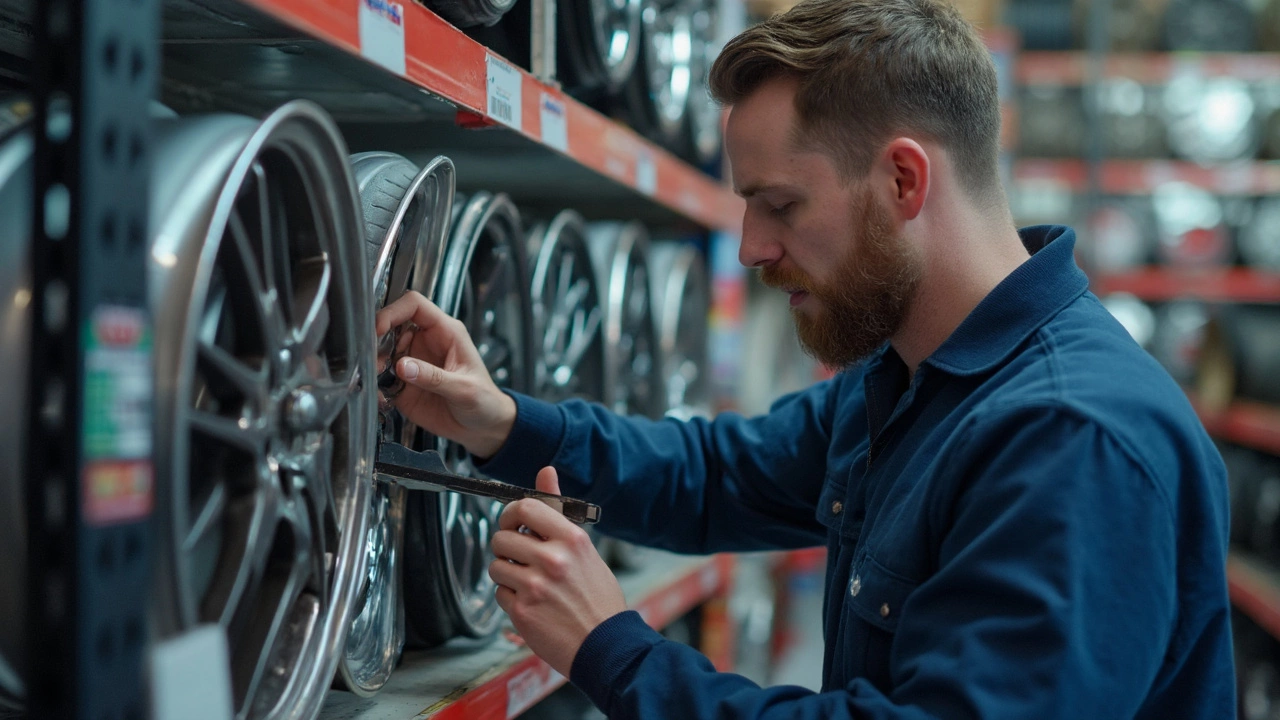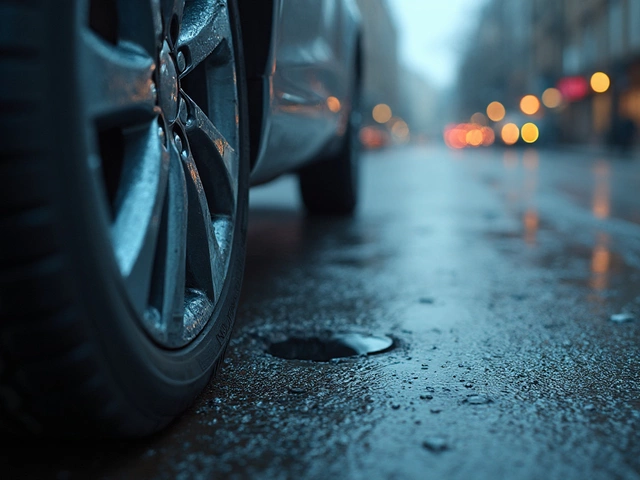Think buying new rims is just about picking a cool style? Get this wrong and you’re stuck with wobbly drives, scraping noises, and maybe even a broken suspension. The rim world is flooded with options, and not all of them are legit—or safe. A lot of folks just check the color and bolt them on, not realizing even a small size mismatch can mess up the ride.
Here’s the thing: the wrong rim isn’t just a small screw-up. It can wreck your fuel economy, blow out your tires, or make your car look like it’s wearing shoes two sizes too big. Rushing in means you can get fooled by fake brands or end up with weak, brittle alloys. Don’t stress—I’ve untangled this mess and pulled together the most important stuff you really need to know before you reach for your wallet. Let’s save some frustration—and some dollars—right now.
- Why Rim Fitment Matters
- The Truth About Rim Materials
- Spotting Fake and Low-Quality Rims
- Common Buying Mistakes (And How to Dodge Them)
- Essential Questions to Ask Before Purchasing
Why Rim Fitment Matters
Nailing the right fit isn’t just for looks—it’s for safety, comfort, and even saving money. When the fit is off, you risk damaging your suspension, messing with your steering, and even hurting your brakes. Let's get into why proper rim fitment is a non-negotiable if you care about your ride’s performance.
Every car has a set of measurements for its wheels: width, diameter, offset, bolt pattern, and center bore. If you mismatch any of these, you could run into serious problems. For example, putting too wide of a rim can make the tire rub against your wheel well, especially on turns or bumps. Get the offset wrong and your wheels might stick out too far—or rub inside things they shouldn’t. This can even make your car handle weirdly, like pulling to one side or feeling bouncy on the highway.
- Buying rims with the wrong bolt pattern means they won’t even go on. Don’t guess—always check your car manual or the old rim for correct specs.
- Offset (measured in mm) is your friend and enemy—if it's way off, stress is put on your bearings, and you’ll burn through tires faster.
- Too big or small of a center bore? You’re cruising for vibrations that just won’t quit, or worse, your rim won’t sit straight at all.
| Fitment Spec | What Happens If Wrong |
|---|---|
| Diameter | Speedometer errors, tire rub, impact on ride comfort |
| Width | Rubbing, poor tire wear, steering issues |
| Offset | Bearing wear, alignment problems, handling changes |
| Bolt Pattern | Rims won’t fit or fasten properly |
| Center Bore | Vibrations, unsafe wheel mounting |
One interesting stat: a 2023 AAA study found that over 20% of vehicles with aftermarket rims had some fitment issue that led to premature tire wear or steering problems. Saving a few minutes on research can cost hundreds in fixes later. Get those numbers right before buying, and you’ll avoid the headaches.
The Truth About Rim Materials
Most folks don’t even ask what their rims are made from. But rim material isn’t just a nerdy detail—get this wrong and you’ll feel it every time you hit a pothole or take a corner too fast. There are three main rim materials on the market: steel, cast aluminum, and forged aluminum. Each has its ups and downs, and knowing what you’re really buying matters more than flashy paint or fancy branding.
Let’s break down the key players:
- Alloy wheels (usually cast aluminum): These are the poster child for style and performance. They’re lighter than steel so your car handles better and the ride is smoother. They also don’t rust as quick, which is a win for anyone dealing with winter salt. Downside? Cheap alloys can easily crack or bend from hard impacts, and extreme budget options are sometimes poorly made knockoffs.
- Steel rims: Super strong and cheap, but heavy. Steel’s great if you’re always dodging curbs or running a beater through winter. You lose out on style points, though, and the extra weight can drag down acceleration and handling.
- Forged aluminum: The expensive one on the list. These are the lightest and strongest rims you can buy—what racers dream of owning. The catch? Your wallet might cry. But you get killer performance and the best durability around.
Here’s a quick look at how these stack up:
| Material | Weight | Strength | Typical Price (USD/rim) |
|---|---|---|---|
| Steel | Heavy | High | $50–$100 |
| Cast Aluminum (Alloy) | Medium | Medium | $100–$300 |
| Forged Aluminum | Light | Very High | $350–$1200 |
If you see a crazy good deal on "alloy wheels," double-check the source. Fake alloys are everywhere now, and they often use cheap materials or shortcuts that leave you with a rim that can snap after a nasty pothole. Look for reputable brands and don’t be shy about asking what exact material you’re getting.
Here’s the real kicker: the weight difference actually changes how your car drives. Swapping from steel to alloy can mean up to 10–15 lbs less per wheel. That helps your suspension react faster and drops unsprung weight, bringing sharper steering and better fuel efficiency. You just don’t get that with cheap, heavy knockoffs.
Bottom line? Don’t buy just on looks. Ask questions about the real material, watch out for counterfeits, and think about how you drive. The right rim material can make your car handle like a dream—or ruin a perfectly good ride.

Spotting Fake and Low-Quality Rims
Getting tricked into buying fake or weak rims is way more common than you’d think. Knock-offs look almost identical to the real thing, but cut corners in all the wrong places. Poor material, sloppy craftsmanship, or even missing safety stamps can mean you’re just rolling the dice with your own safety.
Here’s what you really need to watch out for when buying alloy wheels:
- Brand Markings: Real brands stamp every rim with their logo, serial number, size, and manufacturing details—usually on the rear or inner surface. If a rim looks completely blank or has fuzzy, off-center logos, big red flag.
- Feel the Weight: Cheap imitations often weigh more because they use lower-grade metals. If possible, compare with an original. Lighter typically means stronger when it comes to forged or quality alloy wheels.
- Finish Quality: Run your hand over the rim. Originals have smooth, even coating. Peeling paint, blotchy chrome, or rough welds usually mean low-quality—or worse, fake.
- Price It Right: If it’s new and way cheaper than the dealer or known retailers, something’s off. You’re not getting a miracle deal—you’re being hustled.
Here’s a quick look at the main differences between genuine and fake rims, so you can spot them faster:
| Feature | Genuine Rim | Fake Rim |
|---|---|---|
| Logo & Markings | Clear, detailed, always present | Fuzzy, missing, or wrong details |
| Material Quality | Certified alloy, strong yet lightweight | Mixed or low-grade metals, heavier |
| Price | Matches market value | Suspiciously cheap |
| Finish | Even, smooth, no rough edges | Uneven, chipping, poorly welded |
| Supplier | Reliable shop or official dealer | Unknown online or back-alley sources |
Don’t forget to check if your seller gives a warranty—sketchy sellers almost never do. Real brands back their product because they trust their own quality. One last tip: search the model number online. If it doesn’t show up on the official site, skip it—no rim deal is worth risking your safety or cash.
Common Buying Mistakes (And How to Dodge Them)
Buying alloy wheels sounds simple, but plenty of drivers make mistakes that cost them cash, time, or even their car’s safety. Here’s what catches people out most often—and how you can steer clear.
Mistake 1: Ignoring Bolt Pattern and Offset
If your rims don’t fit your car’s bolt pattern or offset, they won’t go on at all (or they’ll cause weird vibrations and handling issues). You can’t just guess this stuff—grab your car’s manual, or check a trusted online database for exact specs before you buy.
Mistake 2: Going Huge on Size
Big rims look good, but plus-sizing too much can ruin your ride comfort, trash your speedometer reading, and up your tire and fuel costs. Experts at Tire Rack say jumping more than 2 inches in diameter from your original rim size usually causes headaches, not just extra style points.
Mistake 3: Choosing Poor Quality Alloys
Cheap isn’t always a win. Low-quality alloys are often weaker—and a weak wheel can crack or bend under a pothole. Stick to reputable brands. If the deal seems too good, it probably is. Ask for TUV or JWL certification, which shows the rims passed real safety tests.
Mistake 4: Not Factoring in Tire Costs
Switching rim sizes means you need new tires, and larger rims use pricier, lower-profile rubber. Some people forget this, then get sticker shock at the tire shop. Check tire prices before you commit.
Mistake 5: Falling for Fake Brands
The market’s full of knock-off designs stamped with fake logos. Not only is this illegal, but fake wheels are risky—they often fail quality checks. Always buy from authorized dealers and ask for proof of authenticity.
- Always check fitment against your car’s specs.
- Don't increase rim size by more than 2 inches without expert advice.
- Look for manufacturing certifications (TUV, JWL).
- Get a quote on tire prices that fit your new rims.
- Buy from reliable stores—not sketchy marketplaces or parking lot "deals."
Want to see common pain points side by side? Here’s a quick table from real customer feedback in 2024:
| Mistake | % of Buyers Affected (2024) | Typical Outcome |
|---|---|---|
| Wrong bolt pattern/offset | 19% | Wheels won’t fit, funds lost on returns |
| Oversized rim selection | 13% | Rough ride, extra tire costs |
| Poor quality/fake alloys | 8% | Bent rims, safety risks |
| Underestimating tire prices | 7% | Blown budgets, installation delays |
Bottom line: double-check every detail, not just the style. The right move saves you money, hassle, and a lot of headaches down the road.

Essential Questions to Ask Before Purchasing
Before you drop cash on new alloy wheels, you’ve gotta ask the right questions. Dealers and websites don’t always lay it all out for you, and missing a detail could mean a lot of wasted time—and money. Here’s what should be top of mind when you’re in the market for rims.
- Will these rims fit my car’s bolt pattern and offset? Not all rims fit all cars. If the bolt pattern or offset is off, you’re in for a rough ride. Ask for the exact specs and match them with your car’s manual. Some cars use 5x114.3; others are 4x100, for example. Don’t just eyeball it.
- How much do the rims weigh? Heavier wheels tank your fuel economy and can slow down your acceleration. Lighter doesn’t always mean better, but factory wheels usually fall between 18 to 26 pounds. Ask for the rim’s weight and compare it with your originals.
- Are these wheels certified? Look for certification logos like JWL (Japan Light Alloy Wheel) or VIA. Real certifications mean the rim’s been tested for safety. If your rim is missing those, walk away.
- Are these genuine or replica wheels? Some replicas look identical but won’t hold up with potholes or sharp turns. If the price seems too good to be true, ask for proof of the brand and a warranty—and check online reviews from real customers.
- What is the return or exchange policy? Even with all your research, a mismatch can happen. A good shop will give you some wiggle room to return or exchange, usually within 14 to 30 days. Always push for clarity here.
Want some quick data? Here are a few specs that shops use to describe rims—and why they matter:
| Spec | Typical Range | Why It Matters |
|---|---|---|
| Bolt Pattern | 4x100, 5x114.3, etc. | Must match your car’s hub for proper fit |
| Diameter | 15"–22" | Impacts handling, looks, and tire costs |
| Width | 6"–10" | Affects tire choice and traction |
| Offset | +15mm to +45mm (most cars) | Wrong offset can cause rubbing or poke |
| Weight | 18–30 lbs | Too heavy or too light both have drawbacks |
Don’t feel rushed by deals or limited-time sales. Dealers move fast, but making a snap decision can haunt you later. Show up with your specs in hand. Cross-check with your manual, ask for certifications, double-check weight, and always, always check the bolt pattern before you buy. Your ride—and your wallet—will thank you later.


